
- K-12 Resources
- Can I Recycle That?
- Log In / Sign Up
- My dashboard

Teach Kids to Write an Opinion Piece on Zero Waste Schools
Staff Writer

All kids have opinions, and most of them are not afraid to share them! As you take steps to become a more sustainable school, one of the most effective ways to engage students is to ask what they think. Enter the power of opinion writing (aka persuasive writing or argumentative writing).
By asking kids to write an opinion piece on becoming a zero waste school, they will naturally learn about the importance of this topic. This is also a great writing activity for introducing cross-curricular teaching about zero waste topics . Here’s an easy, seven-step system for how to teach opinion writing on this topic. It might just help your school with their recycling and zero waste efforts, too!
1. Read mentor texts to better understand opinion writing
Opinion writing can often be tricky for students, not because they don’t have opinions but because it goes against what they’ve already learned about writing. They no longer have to avoid phrases like “I think” or “I believe.” They’re now encouraged! One of the best ways to get students in the right frame of mind is to read mentor texts on opinion writing. This can include picture books like the ones on this great list . It can also include articles you find in newspapers or online. For instance, here’s a piece about How Recycling Can Be the First Great Step Towards Becoming a Zero Waste School , and here’s another, How School Recycling Changed My Classroom and Community for the Better . Finding a piece on the subject students will be writing about will help them to make connections and start forming their own opinions.
2. Introduce the topic, and invite students to share
Once students have a good grasp of opinion writing from the mentor texts, go ahead and introduce the topic—zero waste schools. (If you already introduced the topic when you read the recommended pieces above, that’s fine.) Invite students to share their thoughts about zero waste schools. Here are some question prompts to get the discussion going:
- What do you think zero waste means?
- Would you want our classroom or school to be zero waste? Why or why not?
- Would you want your home to be zero waste? Why or why not?
- How would it be hard to be zero waste? And what would make it easier?
- Should we encourage others to be zero waste? Why or why not?
3. Research and learn
After you’ve let students share their initial opinions, it’s time to do more digging and learning about the topic. Depending on their age, you can either let them do this independently. You could also give them some sources to check out. Here are a few good ones:
- Recycling Discussion Topics , PepsiCo Recycling
- Be a Food Waste Warrior , World Wildlife Fund
- Zero Waste for Schools , Green Schools National Network
- Questions Schools Should Ask About Going Green , PepsiCo Recycling
- School Programs to Help You Recycle , WeAreTeachers
- 29 Ideas to Bring Recycling into the Classroom , WeAreTeachers
4. Hold a second round of sharing
If you have the time, try having another round of sharing now that you’ve researched the topic. Encourage students to widen and even change their opinions based on their new knowledge. You can use the same questions from above or ask new ones.
5. Use a graphic organizer to prepare for the essay

Before students sit down to write, have them prepare by using a graphic organizer specifically for opinion writing. You can use this free one here . Don’t let students skip this step! It’s an important part of the process that can really help get organized. This is not just for formulating their opinions, but it’s also to help them make sure they have reasons to back them up. It’s the oh-so-important “because” that they’ll need to write about. It’s easy to state an opinion, and filling out a graphic organizer will help students figure out their “because” to ultimately write a strong essay.
6. Time to write
There are, for sure, a lot of different strategies for teaching opinion writing. We like to break down all the thinking for each part of the writing piece. Try this free graphic organizer to help you share your expectations .
7. Celebrate the essays
After your students have written essays, take time to recognize their unique thoughts and ideas. You might even celebrate the essays by hanging them up on display or sharing some of them with your administrator or school board. They could even help you in your efforts to go zero waste. When students speak, especially on topics like these, it can be very empowering.
Good luck creating opinion essays about zero waste with your students. Often, small suggestions or ideas that surface from these essays can make a big impact. Yet, we don’t always see them when we’re in the depths of planning. So this can be a great opportunity to bring them out and recognize them in positive ways.
Related Content
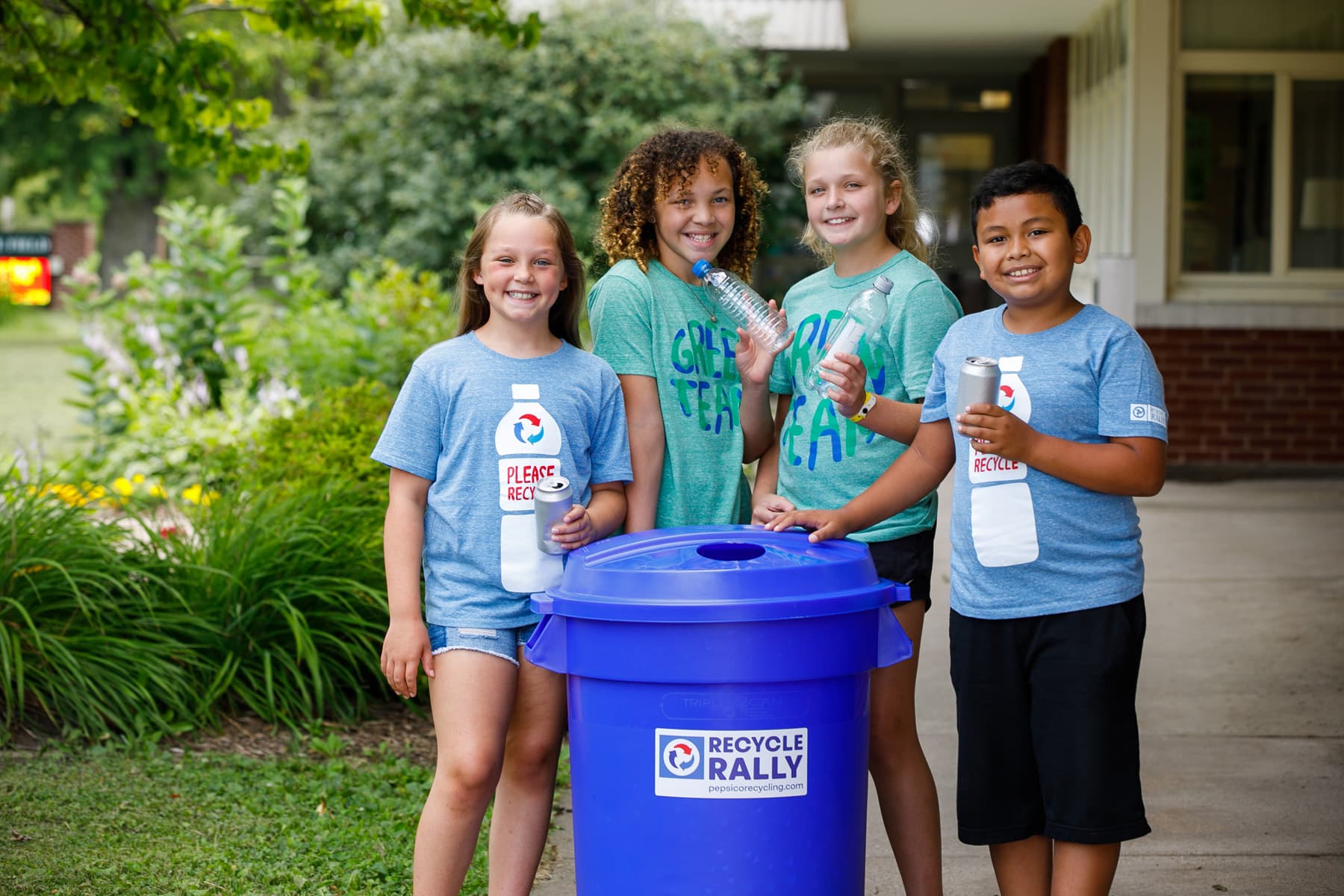
Recycle Rally
Recycle Rally is a free K-12 program that provides rewards and tools to help enhance recycling at your school!
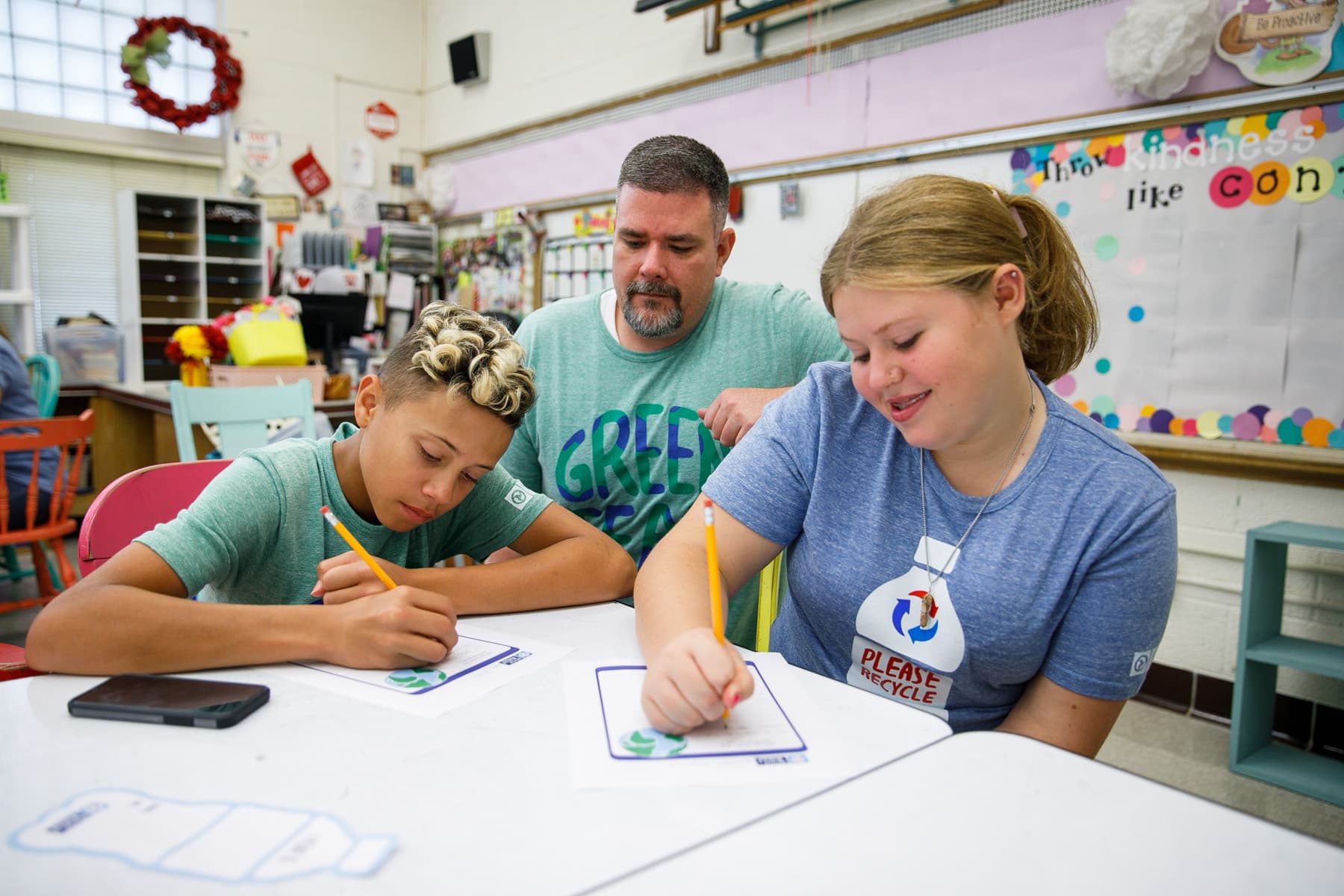
Additional Resources
Our comprehensive library of resources was designed to inspire the next generation of green leaders.
Opinion: Ours is the most wasteful civilization in history. Here’s how to stop that

- Show more sharing options
- Copy Link URL Copied!
What if the looming calamities of climate change, plastic pollution, the energy crisis and our whole environmental doom-scroll are symptoms of just one malady and it’s something we actually can fix?
That’s right, the planet is fighting a single archvillain: Waste.
Americans live in the most wasteful civilization in history. This goes way beyond what we roll to the curb each week. It’s rooted in what we eat and drink and how we cook. It’s the main thing you pay for in your utility bills and at the gas pump. Waste is so deeply embedded in our economy, products and daily lives that it’s hard to see clearly, or to see at all.
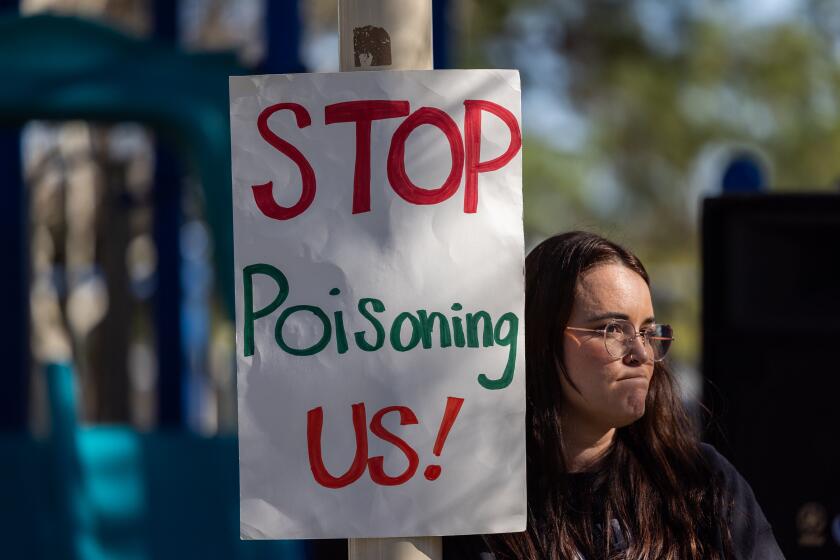
Editorial: Chiquita Canyon Landfill’s toxic fumes show the danger of continuing to dump our trash
For decades, landfills have been the cheapest, easiest way to deal with the mountains of garbage people dispose of every year. Now we have to deal with the impact on neighbors and the climate.
March 13, 2024
Thinking of seemingly unsolvable Earth-destroying crises as byproducts of waste is powerful and hopeful. There’s no partisan divide where one side says, “Yay waste!” Instead there are ordinary blue state and red state people at work in our neighborhoods right now, showing us how to tackle waste and the catastrophes it drives — and saving, even making money while doing it.
The best opportunity for healing our economy, quality of life and the planet begins with reframing the entire doom-scroll as waste. What we choose to use is important, but it’s what we squander that’s killing us.
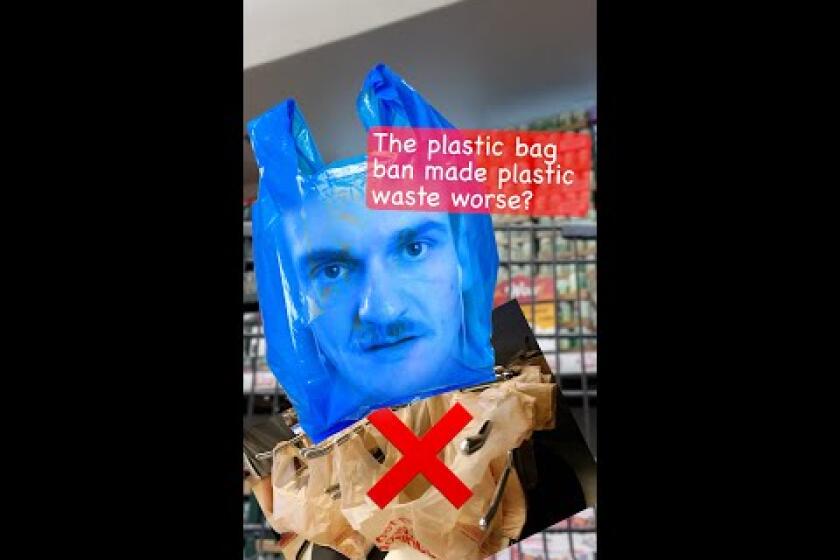
Climate & Environment
Did California’s plastic bag ban make plastic waste a bigger problem?
It’s been 10 years since California banned single-use plastic bags and our plastic bag waste per pound has…GONE UP?!
Feb. 21, 2024
Don’t believe it? How is it “normal” that 40% of what our industrial farm and food system produces ends up as garbage? Where’s the outrage over a fossil-fuel-dominated energy system that wastes two-thirds of the $1.3 trillion we spend each year on fuel and electricity? Why no protests over miles-per-gallon fuel economy ratings that ignore how every gasoline car wastes $4 out of $5 we spend at the pump?
The average American throws out three times more trash today than in 1960. Pin much of that garbage growth on plastic waste, so pervasive now that tiny bits of it are in food, water, beer and even human hearts, lungs and newborn babies’ poop. The World Wildlife Fund estimates that we swallow up to a credit card’s worth of plastic every week ! Yet we keep buying it and chucking it, because that’s “normal.”
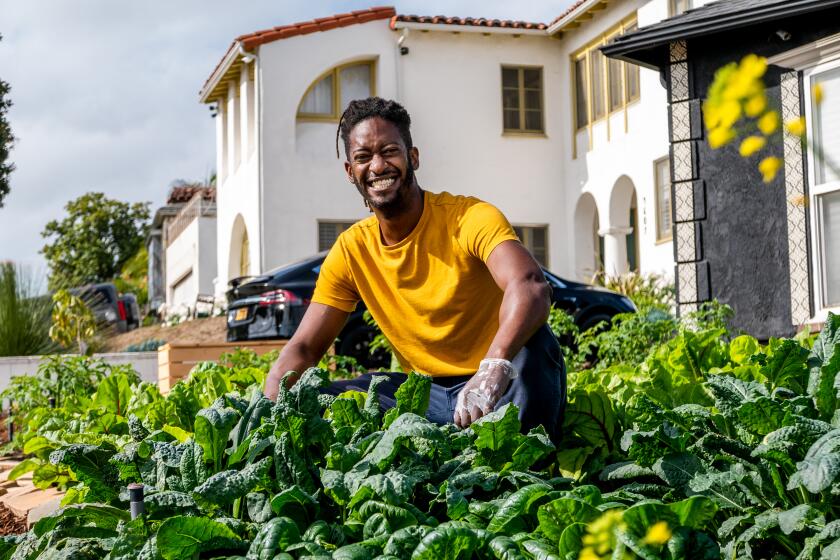
‘Microfarms’ come to South L.A. frontyards, bringing fresh produce to food deserts
Jamiah Hargins wants microfarms to feed Los Angeles one frontyard at a time.
May 13, 2021
But wastefulness at this level is neither normal nor inevitable. We can make different choices. Start with some (or all) of these five waste-fighting moves that aren’t about giving up stuff you love, but upgrading to things you’ll love more:
Kill your lawn and plant a vegetable garden . It’s one of the best things you could do for the planet’s health and your own, and you’ll get tastier, more nutritious veggies with no trips to the grocery store. You could also support the fight against what Jamiah Hargins calls “food apartheid.” His South Los Angeles nonprofit, CropSwapLA , builds front-yard urban microfarms in food deserts that can turn 1,000 square feet of grass into enough veggies and fruit for 25 to 40 families a week. “Why mow your yard,” Hargins asks, “when you can eat your yard?”
Turn off your gas stove. The main thing we’re cooking with gas is the planet — and our kids’ lungs. So cut it out. Gas stoves waste 70% of their fuel and create a 42% higher risk of childhood asthma . Not up for a major appliance upgrade? Try an inexpensive countertop induction cooker (as little as $65) for everyday, and reserve gas stoves for feasts (windows open, please). Chef Rachelle Boucher , once George Lucas’ private chef and now with the Bay Area’s Building Decarbonization Coalition, became a superfan of induction stoves ( cooking with magnets, not flames ) after switching off the gas all but ended her husband’s asthma attacks.
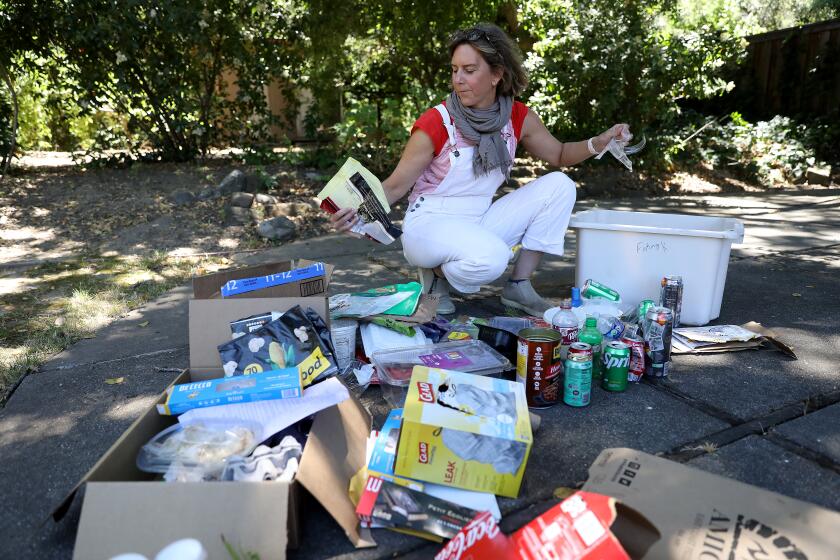
A reporter kept a diary of her plastic use. It was soul-crushing
Plastics are everywhere. As an environment reporter, I make informed choices when shopping, trying to minimize the amount I bring in. Or I thought I was.
Aug. 15, 2023
Just say no to disposable plastics. Plastics are waste incarnate, says Bay Area-based Anne-Marie Bonneau, the Zero Waste Chef . Most plastics are rarely recycled and bags and wraps never are. (Yes, we’ve been lied to for decades.) Plastic containers can release toxins into food, she says, especially when heated — so don’t ever microwave in plastic! Go with glass or metal containers, whether reusable or single-use. Save money on bags and wraps by reusing peanut butter, pickle and jelly jars for food storage. Bring your own grocery bags.
Support “polluters pay” laws . Officially known as producer responsibility laws, these statutes shift the cost of recycling (or lack thereof) from taxpayers back to the producers of things like plastic soda bottles. Maine stepped up first, and other states followed. California’s “polluters pay” law doesn’t go live until 2028, and you can bet all kinds of industries will spend that time trying to water it down. It’s up to us to keep the pressure on officials to hold the line. This isn’t regulation, says environmentalist Sarah Nichols , architect of the breakthrough Maine law. It’s pay-for-what-you-break capitalism — an incentive to make less polluting and more reusable products.
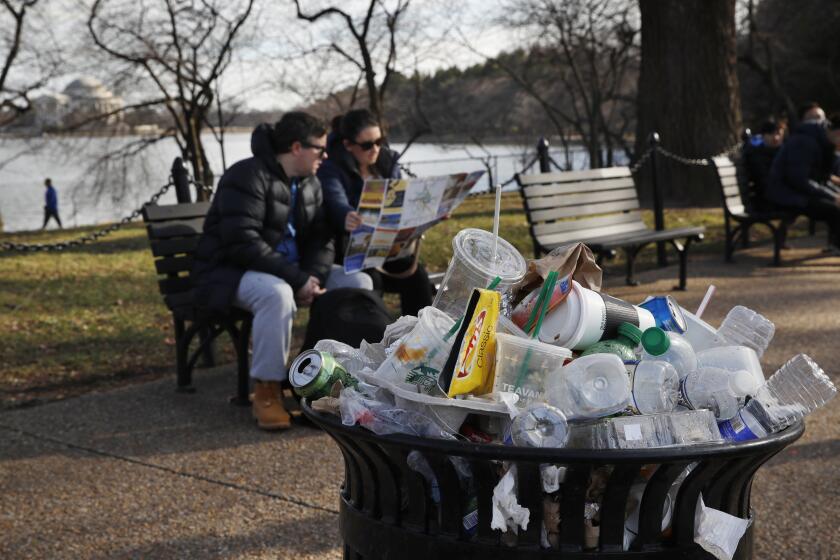
Newsom signs nation’s most sweeping law to phase out single-use plastics and packaging waste
The legislation heads off what would be a costly and contentious ballot measure and pushes California ahead of the world in the fight against plastic waste.
June 30, 2022
Drive the real vehicle of the future : Take advantage of the fact that the average driver travels only 37 miles a day , and most of our trips are 10 miles or less. Which means EV “range anxiety” is a marketing and media creation. Why not try parking your gas-wasting car for short trips and ride-share, borrow or buy an eBike, e-scooter or street-legal electric golf cart. Just ask Mayor Kim Learnard of Peachtree City, Ga., where 39,000 residents have made mini-EVs their money-saving, traffic-dodging mainstay : “It’s made driving fun again.”
Once you start seeing waste clearly, you won’t be able to stop. And once you experience the benefits, you won’t want to. This is how change spreads and how we turn the tide. Rethinking waste as our archvillain isn’t just a word game — it’s the secret sauce that turns anxiety and inertia into hope and action, because waste is the one big problem anyone can do something about.
And collectively, our choices do matter: They can drive the policies we need and overturn ones we don’t, they can move markets, they can make harmful products lose to beneficial ones, and they can make, break or remake economies. And, yes, they can help save the planet, too. Just by being less trashy.
Edward Humes is a Pulitzer Prize-winning journalist. His latest book, “Total Garbage: How We Can Fix Our Waste and Heal Our World,” will be published in April.
More to Read
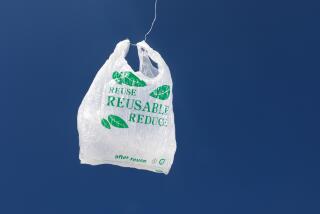
Opinion: California faces an uphill battle against plastic
Feb. 22, 2024
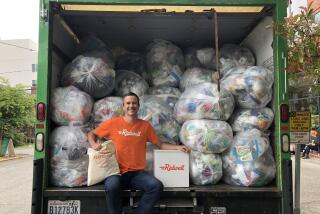
Need to get rid of your junk and your consumer guilt? There’s a subscription for that
Jan. 15, 2024

Letters to the Editor: Greening your home is great, but nothing beats climate legislation
Jan. 10, 2024
A cure for the common opinion
Get thought-provoking perspectives with our weekly newsletter.
You may occasionally receive promotional content from the Los Angeles Times.
More From the Los Angeles Times
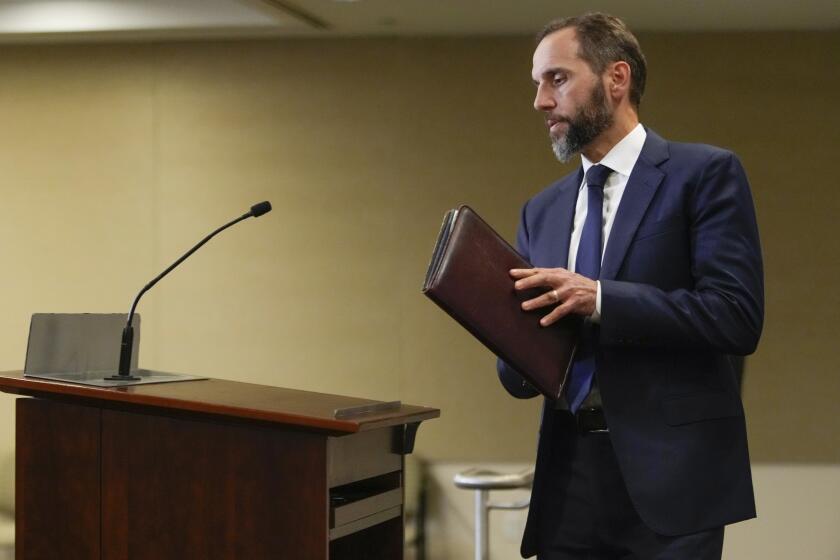
Litman: How Jack Smith just called out Judge Aileen Cannon in the Trump classified records case
April 3, 2024

Opinion: Struggling to get help with college through the FAFSA? Here’s why you shouldn’t give up
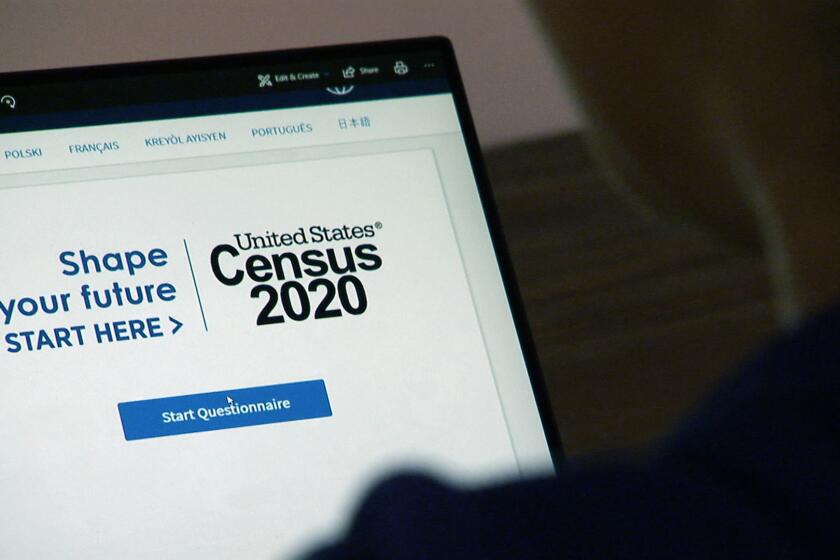
Opinion: Latinos are getting out of the ‘other’ box on the U.S. census

Abcarian: I wanted to hate what UC Berkeley parents are doing in the name of safety, but I can’t
PRESENTED BY HELLMANN'S

- ENVIRONMENT
Whatever happened to the zero waste movement?
Plastic straw bans sparked a movement in the 2010s. Have our sentiments around plastic and zero waste changed since then?
It was a pleasant summer day along the waters off the coast of Guanacaste, Costa Rica when marine biologist Christine Figgener captured the heartrending video that sparked the movement to ban plastic straws.
While collecting data on olive ridley sea turtles, she and her colleagues would routinely lift the creatures up onto their boat for examination. Upon inspection of a sea turtle on August 10, 2015, they found that it had something peculiar lodged in its nose. At first, Figgener and the other scientists onboard speculated that the object could be a barnacle or a tube worm. But as the full length of the item emerged, the turtle wiggling with discomfort, they quickly realized it wasn’t something organic—it was a plastic straw.
“It was mind boggling,” Figgener recalls. And while the straw so deeply lodged into the creature’s nostril was distressing, she notes that plastics permeating their way into marine life was nothing new. “As researchers, we have always known that plastic is a problem.”
Plastic production underwent an explosive increase from two million tons produced in 1950 to over 290 million tons in 2023 , and by the late 1950s, there were already numerous scientific records of marine turtles ingesting plastic bags . But it wasn’t until Figgener’s video, and other viral images of marine life entangled in plastic proliferated across the internet that plastic use, and straws in particular, caused a public outcry.
Throughout the 2010s, anti-straw and zero waste trends took the internet by storm, and the infamous “trash jar” was born. Going plastic free was simultaneously a trendy aesthetic, a marketing tagline for businesses, and a political movement—more than twenty cities around the country placed strict regulations around plastic straws.
But did this movement make a difference for the environment, or merely distract us?
Was the movement flawed from the beginning?
In 2015, Kathryn Kellogg, author of 101 Ways To Go Zero Waste , began her zero waste journey to save some money and live a healthier lifestyle. The idea of keeping a trash jar compelled her as a fun challenge. To hold herself accountable, she began sharing her journey online .
FREE BONUS ISSUE
But throughout her two years of keeping a trash jar, Kellogg and the zero waste community started noticing stark flaws within the movement. A perfectly zero waste lifestyle began to feel time consuming and impractical. Many felt dispirited for not being able to meet the standards of living a “zero waste” lifestyle and noted that all this individual effort did little to stop the flood of new single-use plastics entering the waste stream every day.
( A brief history of how plastic straws took over the world. )
“Living in San Francisco, so much was available package-free, but that doesn’t necessarily translate to many other areas across the country,” says Kellogg. “And it’s impossible to be completely zero waste, because we don’t live in a society that is built that way.”
The movement also relied heavily on consumerism. For every jar that one could put their trash in, there was an aesthetically pleasing jar to purchase from a “Zero Waste” brand. For every step individuals could take toward zero waste, there was an item that “needed” to be bought in order to get them there. Rather than calling attention to working with what we already have, and simply buying less, it was still grounded in producing and shipping more “things.”
Figgener fears the public also became too focused on villainizing straws, rather than looking at plastic production itself as the problem.
While plastic straws themselves are certainly a detriment to many species , they make up only 0.025 percen t of the staggering eight million tons of plastic that flow into the ocean each year— which equates to about two garbage trucks’ worth of plastic entering the ocean every minute .
“Straws are such a small percentage of all of the single-use plastic that we’re using,” she says. “For companies, banning them became something they could do to appease the masses. They got rid of straws but didn’t tackle the rest of the supply chain plastic that we’re creating.”
How the pandemic changed the narrative
Amid the COVID-19 pandemic, the sentiment around the zero waste movement started evolving.
“The movement had become so focused on individual responsibility, which is absolutely very important, but the conversation shifted more towards: how can business be supporting us better, how can policy be supporting us better?” says Kellogg.
You May Also Like

Let’s not waste this crucial moment: We need to stop abusing the planet

5 simple things you can do to live more sustainably
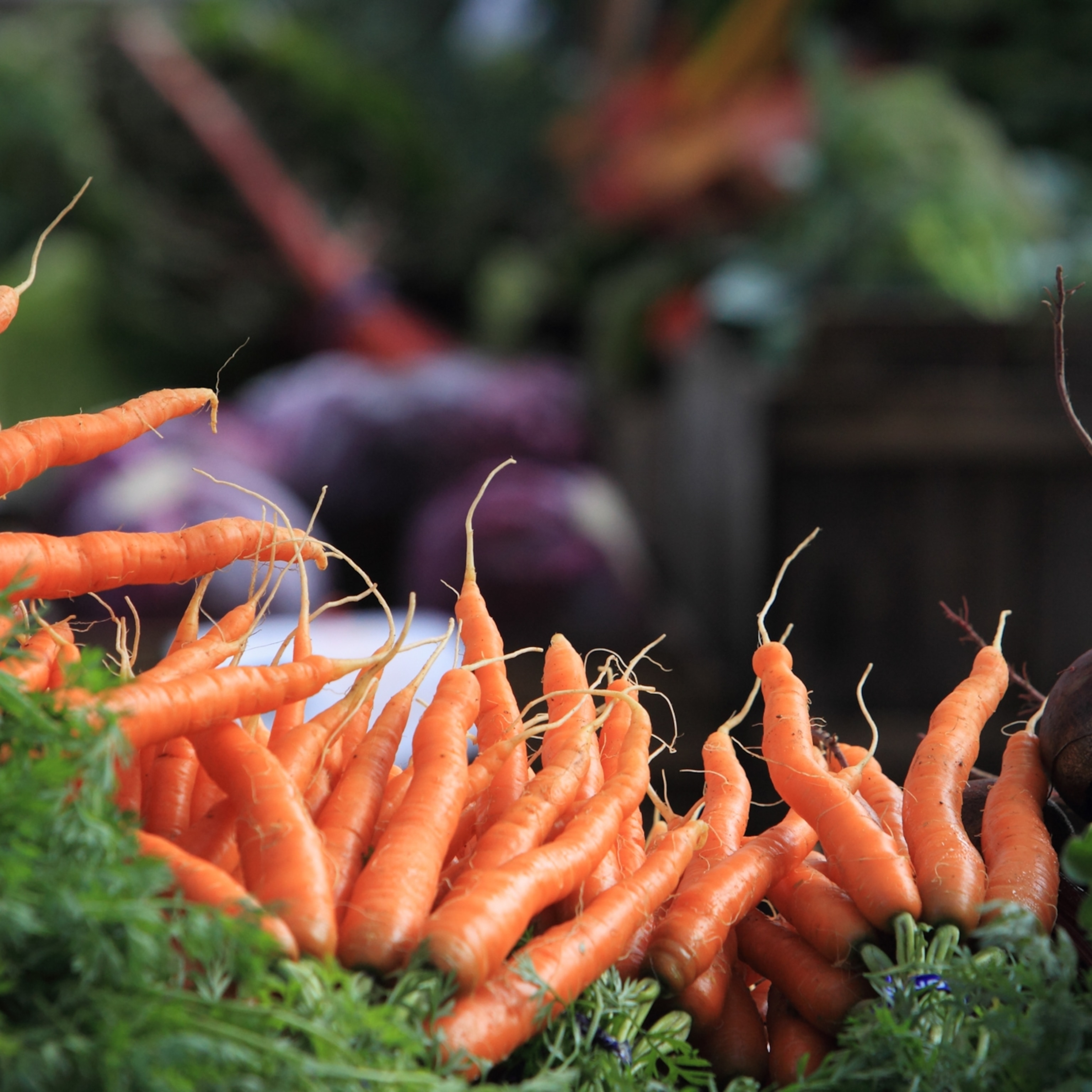
Counter or fridge? Here’s how to store fruits and veggies for maximum freshness
( Microplastics are in our bodies. How much do they harm us? )
Around this time, environmental author and educator Leah Thomas started highlighting ways the zero waste movement had excluded entire communities.
“A lot of lower income people and people of color were kind of blamed or shamed for not being able to participate in the movement, because it was viewed as something expensive,” says Thomas.
Thomas noted that without an inclusive approach, bans could inadvertently harm those who are already among the most vulnerable in society, such as individuals who require plastic straws to eat and drink. Covid lockdowns were a stark reminder of this, she says, showing that in hospitals, for instance, specific single-use items may be essential.
“Sometimes, it’s taken out of the equation that people are existing in systems that are imperfect, and should have a bit of grace,” continues Thomas.
Reducing plastic from the top down
As the zero waste movement lost much of its luster, more organizations started pushing for policies that make it easier for individuals to reduce their plastic usage.
Beyond Plastics , a nationwide project that launched in 2019, is one nonprofit pushing for national policies to curb plastic pollution. The organization has over 100 chapters across the country that also push for local and state-level policy change.
Notably, their advocacy does not push for recycling.
Only 5-6 percent for post-consumer plastic waste in the US is actually recyclabl e, and the per capita generation of plastic waste has increased by 263 percent since 1980 . Thomas notes that plastic usage in the U.S., even when recycled, has also harmed other countries . Millions of tons of plastic waste, often collected from recycling plants, are shipped to low income countries that don’t have the infrastructure to prevent pollution caused by plastic entering waterways or being incinerated.
“The biggest thing to keep in mind is that the plastic pollution problem is not going to go away without reduction—we’re going to have to reduce the production and use of unnecessary single-use plastic.” says Melissa Valliant, communications director at Beyond Plastics. Instead, the organization wants citizens to advocate and vote for policies that curb plastic production.
( This is why your recycling doesn't always get recycled. )
In February, Oceana released polling results that showed 83 percent of American voters are concerned about single-use plastic products, and 84 percent of American voters support requiring companies to reduce single-use plastic packaging.
But within the G20 countries , the U.S. is only one of four that has yet to impose a nationwide ban on single-use plastics. A recent report noted that a 75 percent cut in plastics is needed to limit global warming to 1.5°C, and that the U.S. generates significantly more plastic waste than any other country , producing roughly 287 pounds of plastic per person, per year.
While the U.S. has not placed a single-use plastic ban at the federal level, the responsibility has been taken up by some cities and states that have pushed their own policies attempting to limit plastic pollution. California, Connecticut, Delaware, Hawai’i, Maine, New York, Oregon, and Vermont have all placed bans on plastic bags. Since California implemented the ban in 2014, the state saw a 70 percent reduction in plastic bag usage.
Albeit flawed, environmentalists say the zero waste movement helped make the environmental threat of plastic a mainstream issue.
“In a lot of ways, straw bans were good stepping stones, and now people are able to dig deeper and know that the problem is much larger,” says Christine Figgener. “It’s not just about saving sea turtles, it’s about saving the basis of life for our own species. We need clean air and clean water within our own habitat and ecosystem. If we don’t understand that, nothing will change.”
Related Topics
- PLASTIC WASTE
- SUSTAINABILITY
- GREEN LIVING

Microplastics are hidden in your home. Here’s how to avoid them.


Which leafy greens are healthiest—and which might make you sick?

See scenes from classic fairy tales—with a Nigerian twist

Simple ways to make your laundry routine more eco-friendly

Home sweet … garbage? The Great Pacific Garbage Patch is teeming with life
- History & Culture
- Photography
- Environment
- Paid Content
History & Culture
- Mind, Body, Wonder
- Terms of Use
- Privacy Policy
- Your US State Privacy Rights
- Children's Online Privacy Policy
- Interest-Based Ads
- About Nielsen Measurement
- Do Not Sell or Share My Personal Information
- Nat Geo Home
- Attend a Live Event
- Book a Trip
- Inspire Your Kids
- Shop Nat Geo
- Visit the D.C. Museum
- Learn About Our Impact
- Support Our Mission
- Advertise With Us
- Customer Service
- Renew Subscription
- Manage Your Subscription
- Work at Nat Geo
- Sign Up for Our Newsletters
- Contribute to Protect the Planet
Copyright © 1996-2015 National Geographic Society Copyright © 2015-2024 National Geographic Partners, LLC. All rights reserved
- Share full article
Advertisement
Supported by
Responsible Fashion
World-Class Lessons on Zero-Waste
Designers from around the world find inspiration in traditional garment making in their quest to eliminate fabric waste.

By Hahna Yoon
This article is part of a series examining Responsible Fashion , and innovative efforts to address issues facing the fashion industry.
Bhaavya Goenka grew up watching trucks filled with discarded textiles from her parents’ garment factory in Jaipur, India, headed to nearby landfills. In 2017, inspired by that childhood memory, Ms. Goenka, 27, founded Iro Iro, a fashion label and service that reclaims textile waste and uses it according to indigenous practice. She is one of a growing number of designers representing their traditional cultures in the conversation about zero-waste fashion.
“There is this consciousness around textiles and materials that existed in our collective cultures for a long time, and I’m just trying to draw inspiration from that,” Ms. Goenka said. Iro Iro’s mission includes collaborating with design houses to collect their scraps, breaking them down into smaller pieces and working alongside artisans in villages to weave them into new fabrics. In addition, Ms. Goenka occasionally designs zero-waste collections of her own.
The language used to describe traditional Indian garments may not fit into the contemporary lexicon of sustainable fashion, but such designs are inherently zero-waste, Ms. Goenka said. She explained how each of India’s 28 states applies zero-waste pattern-cutting techniques to suit its climate. “In Kashmir, where it’s very cold, they wear these wool gowns with long sleeves called pheran. Down south, where it’s hot and tropical, people wear kurtis , which are made with more breathable fabrics. Any type of Indian clothing that’s colloquially worn, like the sari, choli, lehenga, kurta, do not have shapes that leave behind waste.”
Ninety-two million tons of textile waste is created every year, and according to the United Nations, the fashion industry is responsible for as much as 10 percent of humanity’s carbon emissions. A report by the World Economic Forum in 2021 named fashion, along with its supply chain, the world’s third largest polluter and later that year, the Australian Climate Council released a statement linking fashion’s environmental effects to fast fashion in particular. Consumers today are more likely to purchase clothing more often and by 2030, global apparel consumption is projected to rise to 102 million tons a year, from today’s 62 million tons.
While no one is sure exactly how much waste is generated during production, Timo Rissanen, associate professor of fashion and textiles at the University of Technology Sydney, estimates roughly that 15 percent of textiles are discarded in the cutting process alone. Part of the problem is that it’s difficult to keep large retailers accountable. Even companies such as H&M and Uniqlo , often thought of as pioneers in sustainable fast fashion, have been called out for their lack of transparency.
In 2015, Professor Rissanen, 47, wrote, with Holly McQuillan, a book called “Zero Waste Fashion Design,” a term it defined as “fashion design that wastes no fabric, by integrating pattern cutting into the design process.” In the book, he called this practice as “old as dressing the body with skins and cloth” and focused on pattern cutting, but proposed that fabric waste is not the only consideration in zero-waste design. While seeking to eliminate fabric waste, the designer must also be aware of how the clothes look and fit, how they are made and what they are made with.
Most cultures around the world have long traditions of working with materials respectfully, but the discourse about zero-waste fashion is overwhelmingly Western, Professor Rissanen wrote via email. “Fashion and discourse about fashion ought to be as diverse as humanity, and that realignment is thankfully in motion,” he said.
No Scrap Left Behind
Duni Park, a 47-year-old Korean designer based in Tokyo, founded Gallery Shili, a sustainable women’s wear brand, in 2011. Each kimono is made of eight rectangular strips cut from a single bolt of cloth, also called a tanmono, Ms. Park explained over email. When making a kimono, alterations to the fabric are kept to a minimum, and when curved shapes are necessary, the fabric is delicately folded and stitched instead of cut — as in origami. Any excess length is hemmed up rather than cut off: “There is 0 percent waste of the original fabric,” she wrote.
Ms. Park, who finds secondhand kimonos in Japan and reinterprets them for a more movement-friendly design, said hers was “not a nostalgia-driven brand.” Instead, she is inspired by the zero-waste nature of kimonos to create modern zero-waste looks. “When you break apart a kimono, it goes right back to the original fabric, as if nothing had ever happened to it,” she said. “It’s like a whole new blank canvas is given to you to draw anew.”
Like many owners of sustainable businesses, Ms. Park struggles to evaluate sales per value or production, but her line has expanded from one collection of scarves to 11 different lines of coats, jumpsuits, shirts and shoes. She said she had also learned to use the fabric she has more efficiently. “Ten years ago, we would upcycle 30 kimonos into 30 scarves, but now we are creating up to 200 items with 80 to 90 kimonos,” she said.
For Adeju Thompson, a 31-year-old Yoruba designer in Nigeria, zero-waste design is also about connecting with nature. He is the founder of the Lagos Space Programme, a luxury label founded in 2021 that specializes in nonbinary fashions. Recognizable for its sleek lines and bold use of color, Mr. Thompson’s clothes are inspired by both his queer identity and his African heritage, he said. One of the line’s signature items is a modern take on the kembe, a type of Nigerian wide-legged pants, that, like other Lagos Space Programme designs, creates no textile waste. Additionally, many of Mr. Thompson’s designs use organic dyes, particularly indigo, sourced from plants in the forest.
“It’s a very beautiful, tactile experience — dipping your hands into the water over and over again like a kind of meditation until they turn blue,” he said. While the Yoruba people have traditionally used the organic dyes for adire , a form of storytelling that relies on textiles dyed in symbolic patterns, Mr. Thompson said he was afraid both the sustainable and cultural aspects of the art form were being phased out with the rise of chemical dyes and fast fashion. “Our design practices are very much rooted in our collective identity, which encourages green behavior,” he said.
For many designers, zero-waste practices are as synonymous with community as they are with sustainability. Some spoke about how many types of cultural attire — like saris, kembe, kimonos and hanbok — are not form-fitting, making them easier to pass down from one generation to the next, or to be shared among people of varying sizes within one community.
Sung Ju Beth Lee is a designer of another zero-waste garment — the hanbok, or traditional Korean dress — at Darcygom. The brand, founded in 2017, has collaborated with Korean brands like Ottogi and Oriental Brewery to upcycle their banners to create modern hanboks. Ms. Lee explained that in Korean culture there is a piece of clothing for newborns called baenaet jeogori that is pieced together from secondhand items in the family. The garments have a worn feel that make them softer, and provide a way for elders to pass down loving energy to the next generation, she said.
Ms. Goenka, of Iro Iro, said she inherited her mother’s saris when she died. Although her mother had a different body type, Ms. Goenka said, she is able to wear her saris because the garments are worn through a draping technique that adjusts for size. “There is just so much in terms of body acceptance and body liberation that exists in all of these ancient garments,” she said.
‘The Next Big Thing Is a Lot of Small Things’
Abu Sadat Muhammad Sayem, a research associate at the Manchester Fashion Institute who studies how zero-waste pattern cutting can be applied to mass production, said it was not enough that high-end and custom-made fashion designers are practicing zero-waste design techniques. Instead, the onus needs to fall on mass producers, like Zara, H&M and Marks & Spencer, to cut down on textile waste.
“One of the approaches to improve intellectual fabric utilization is to look at cultural items from different parts of the world and see how it can be applied in the fashion fast styles,” he said. “That may not be the single solution, but it may be one of the solutions.”
Ms. Goenka expressed optimism about the impact that smaller brands can make. She said 80 percent of her company’s revenue comes from collaborations with designers, hotels and factories that want to cut down on their waste.
“I really believe that the next big thing is a lot of small things,” she said. “Lots of smaller brands are working on similar concepts but catering to different aesthetics and forming a diverse tapestry. This is what makes the world go around, and not just seeing 10,000 pieces of the same brand. So, the question is, how can we accept our pasts and use our histories to inform our futures?”

You are here
A future without waste zero waste in theory and practice, about this issue.
Today, in an era of consumerism and cheap, throwaway products, we are producing more waste than ever. In response, many are calling for radical changes in our habits and lifestyles; companies and municipalities are embarking on ambitious plans to become “zero waste.” But is a world without waste truly achievable? The essays in this volume of RCC Perspectives discuss zero waste as a vision, as a historical concept, and as an international practice. Going beyond the motto of “reduce, reuse, recycle,” they reflect on the feasibility of creating closed material cycles and explore real-world examples of challenges and successes on the way to zero waste.
How to cite: Mauch, Christof, ed. “A Future without Waste? Zero Waste in Theory and Practice,” RCC Perspectives: Transformations in Environment and Society 2016, no. 3. doi.org/10.5282/rcc/7540 .
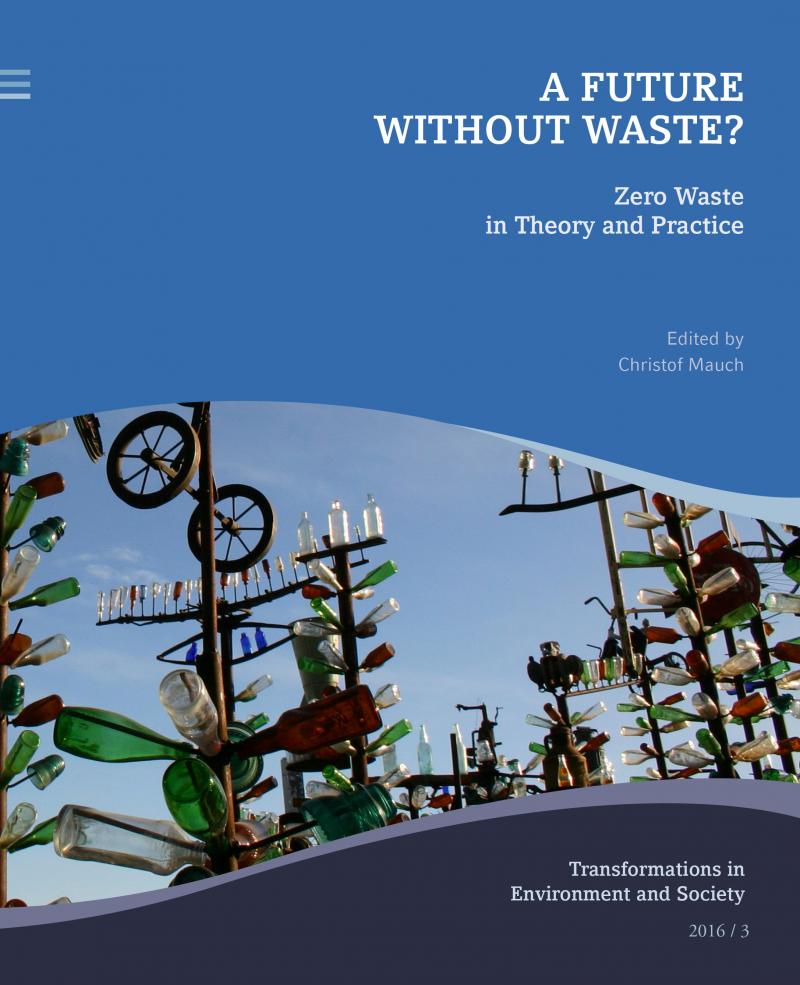
- Introduction: The Call for Zero Waste by Christof Mauch
- An Impossible Ideal: The Use and Misuse of Zero Waste by Tian Song
- Learning to Love Our Ecological Footprint by Michael Braungart
- Why Wait for the Future? There Could be a Present without Waste by Herbert Köpnick
- Waste Utopias: Lessons from Socialist Europe for the Twenty-First Century by Zsuzsa Gille
- Upcycling in History: Is the Past a Prologue to a Zero-Waste Future? by Carl Zimring
Transitions
- Ways Out of the Waste Dilemma: Transforming Communities in the Global South by Jutta Gutberlet
- The Zero Garbage Affair in Bogotá by Stefania Gallini
- Working for Zero Waste in Germany: A Discussion across Disciplines by Eveline Dürr, Martin Faulstich, Christof Mauch, Heike Rieke, Markus Vogt
About RCC Perspectives
RCC Perspectives is an open-access publication that exists to record and reflect the activities of the Rachel Carson Center for Environment and Society. The journal was rebranded in 2016 as RCC Perspectives: Transformations in Environment and Society . It provides a forum for examining the interrelationship between environmental and social changes and is designed to inspire new perspectives on humanity and the wider world. RCC Perspectives aims to bridge the gap between scholarly and non-scholarly audiences and encourage international dialogue.
Guidelines for contributors (English)
The Perspectives Team

Published from 2010 to 2020, the series editors of RCC Perspectives were RCC Directors Christof Mauch and Helmuth Trischler. The former editing team consisted of Harriet Windley and Kristy Henderson. Katie Ritson served as co-series editor and managing editor for many years alongside former editors Brenda Black, Stephanie Hood, Hannah Roberson, and Samantha Rothbart.
Living a Zero Waste Lifestyle Research Paper
Advantages of a zero waste lifestyle, disadvantages of a zero waste lifestyle, status of the zero waste lifestyle, anti-consumerism and a zero waste lifestyle, compact act of san francisco, attitudes towards a zero waste lifestyle, viability of a zero waste lifestyle.
The world is in a dilemma. This dilemma is the result of industrialization, and more recently, globalization. The industrial age coincided with the emergence of fossil fuels as the main source of energy for industrial uses.
The use of fossil fuels, coupled with the massive environmental destruction led to the current situation that the world finds itself. The earth is experiencing global warming, which is threatening the existence of many species, and human life, as we know it.
Carbon dioxide is the main greenhouse gas responsible for global warming, among other gases. This gas occurs naturally from respiration and combustion. However, the burning of fossil fuels, while cutting down trees destroys the capacity of the earth to keep the carbon dioxide levels in the atmosphere within sustainable levels.
This illustration explains the problem of waste management in the world today. The manufacturing models used during the industrial age failed to take into account waste management. The same philosophy drives human consumption today. Human beings produce a lot of waste in the process of utilizing resources.
The aim of this paper is to examine issues surrounding a zero waste lifestyle as a means of eliminating waste from all life processes.
A zero waste lifestyle is one in which no waste results from the utilization of resources in the process of meeting personal needs.
As the name suggests, a zero waste lifestyle is about the taking of initiative to eliminate waste by individuals, cohesive family units, or coordinated communities with the ability to enforce the requirements of the lifestyle. The inspiration behind zero waste lifestyles comes from nature.
Natural systems, such as plant and animal ecosystems as well as physiological processes display a high level of efficiency in the management of resources. The outputs of one process are the inputs of another process, thereby creating a continuous natural cycle in the consumption of resources.
Proponents of the zero waste lifestyle believe that with some forethought, human beings can also attain this state of coexistence with natural resources. As such, people can make a commitment to use resources in sustainable ways at a personal level.
The zero waste lifestyle should dictate the choices that an individual makes regarding how they access and use products. For instance, someone committed to zero waste will use re-useable bags when they go shopping rather than the standard plastic packaging offered in many supermarkets and grocery shops.
The most important advantage of a zero waste lifestyle is that it gives individuals the opportunity to participate in efforts to reverse environmental degradation. The second advantage of a zero waste lifestyle is that it can lower the living costs of a particular individual, family or community.
For instance, choosing goods with smaller packaging reduces the overall cost of buying the packaging because packaging can add a significant cost the price of an item. The third advantage of a zero waste lifestyle is that it demonstrates the direction the entire world needs to take to achieve environmental sustainability.
Finally, living a zero waste lifestyle generates personal satisfaction from the knowledge that the individual’s activities do not harm the environment.
Three disadvantages associated with a zero waste lifestyle are as follows. First, the impact an individual or small community makes towards reversing environmental degradation by living a zero waste life is very small to have a significant effect on the overall destruction of the global environment.
Secondly, some people may experience a reduction in their quality of life if they adopt a zero waste lifestyle. Some of the things that make life in modern societies comfortable come at the price of waste generation.
Thirdly, personal commitment to a zero waste lifestyle can be very frustrating if there is no support from the family, or other people. Lifestyle is what defines social class, hence adopting a waste free lifestyle may make one a social misfit, or a social outcast because of the self-imposed restrictions.
The uptake of zero waste lifestyles is somewhat slow because of the weak legislative and social environment that surrounds the management of waste. The zero waste lifestyle is unconventional. This means that the people likely to take it up are those who can appreciate its benefits based on some higher ideal.
The ideal here is conservation of the planet for the benefit of the future generations. In addition, they may have a desire to live healthier lifestyles because zero waste lifestyles force practitioners to focus in the important aspects of their lives.
The need to keep off junk makes them feel strongly drawn towards healthier lifestyles. For instance, a person may choose to use a bicycle rather than a car, hence deriving the physical benefits associated with riding bicycles.
Based on the observations above, the main socioeconomic groups likely to adopt a zero waste lifestyle are those exposed, and committed to environmental conservation, and to healthier living. They prefer homemade products such as homemade jam, to commercial jams that come with food additives and preservatives.
In addition, they should have a degree of financial incentive from participating in a zero waste lifestyle. Politically, the likely practitioners are idealist thinkers. People in these groups are those in the middle class. A majority of the people practicing the zero waste lifestyle come from this socioeconomic group.
One of the marks of industrial development in the world is a growth in consumer culture. As more members of the society become financially stable, their purchasing power goes up. Consumerism can lead to the purchasing of goods and services that have very little utility.
Some shoppers use shopping as a therapeutic activity leading to wastage of resources in the society. If a zero waste lifestyle represents a life of forethought before making purchases, then consumerism represents a lifestyle where the impact of one’s consumption activities is a distant afterthought.
Consumerism occurs because of the pressure to fit in, chasing after fads and fashion, and because of thoughtless purchases. The amount of wastage that comes from consumerism income countries is very high.
For instance, in the UK, the amount of food discarded is about one third of the total food bought. This can only be the result of a consumer culture.
Promotion of a zero waste lifestyle is the only sustainable way out of the consumer culture most developed countries adopted after achieving high levels of economic growth. Developing countries and upcoming communities need to be encouraged to take up zero waste living to reverse the adverse effect of consumerism.
San Francisco passed legislation that requires the separation of waste at source. All the people living in San Francisco are legally bound by the San Francisco Mandatory Recycling and Composting Ordinance to separate waste into three categories.
Waste is divided into items for recycling, biodegradable materials and those that need to be disposed in landfills. This act is an example of a legislative effort to create a jurisdiction with a zero waste lifestyle. The main elements of the programs created under this act come from the three R’s of waste management.
The three R’s stand for recycling, reusing, and reducing waste, with each R representing the activity needed to deal with various types of waste.
People hold various attitudes towards the zero waste lifestyle. The proportions of people with these attitudes are in a state of flux.
First, there are people who are skeptical about the concept of a zero waste lifestyle. These people feel that zero waste is an idealistic approach to life because of the inevitability of producing waste in the course of living.
The number of people in this category will reduce in line with the increasing concern regarding environmental degradation.
The second major attitude that most people show towards a zero waste lifestyle is ignorance. On paper, many people think that a zero waste lifestyle is a great idea. However, they lack the knowledge and the will to convert this conviction to practical realities in their lives.
The third set of attitudes displayed by a growing minority is one of optimism and faith in the power of zero waste living to change the course of the planet.
An increasing number of people from all over the world are taking certain steps towards environmental conservation at the personal level, based on the principles of a zero waste lifestyle.
These people take the damage humanity causes to natural resources seriously and they choose to take personal responsibility for these actions.
The viability of a zero waste lifestyle is high for committed individuals either in the high or lower socioeconomic status. Individuals have a high capacity to act in very specific ways in the free world. Therefore, at the individual level, more people will join the movement towards zero waste lifestyles.
However, the viability of a zero waste lifestyle is low for large middle class communities if there is no intervention by municipal authorities. This is simply the result of the dilution of the progress made by people committed to a zero waste lifestyle by people living wastefully.
The effort of several families living a zero waste life can disappear simply because of one family that lives wastefully. This means that without intervention, only a certain fraction of the community will pursue zero waste lifestyles based on their convictions.
Similarly, the viability of zero waste living is higher in cities and areas where local authorities use their power to promote zero waste lifestyles. From a socioeconomic standpoint, the chances of living a zero waste lifestyle are much higher for people in the middle class that for the rich.
Colin, B. (2012). My Speech At Green Party National Convention . No Impact Man. Web.
Coon, D., & Mitterer, J. O. (2008). Introduction to Psychology: Gateways to Mind and Behavior. New York: Cengage Learning.
Cooper, E. (2010). The Alternative Kitchen Garden: An A-Z. Hampshire: Permanent Publications.
Dhir, R., Newlands, M. D., & Dyer, T. D. (2003). Sustainable Waste Management. Reston, VA: Thomas Telford.
Frankenberg, C., Meirink, J. F., van Weele, M., Platt, U., & Wagner, T. (2005). Assessing Methane Emissions from Global Space-Borne Observations. Science , 1010-1014.
Harris, F. (2004). Global Environmental Issues. Chichester: John Wiley & Sons.
Holmes, D. (2005). Communication Theory: Media, Technology, and Society. London, UK: SAGE.
Khan, M. M., Prior, D., & Islam, M. R. (2008). Zero-Waste Living with Inherently Sustainable Technologies. In Z. Ayati, M. R. Islam, & J. Biazar, Perspctives on Sustainable Technology (pp. 314-323). New York, NY: Nova Publishers.
Larkley, J. E., & Maynhard, V. B. (2008). Innovation in Technology. New York, NY: Nova Publishers.
Lean, G. (2006). Disappearing World: Global Warming Claims Tropical Island . Web.
Zatzman, G., & Islam, R. (2007). Economics of Intangibles. New York, NY: Nova Publishers.
Zero Waste Home. (2012). Simple Jam Making . Web.
- Chicago (A-D)
- Chicago (N-B)
IvyPanda. (2024, February 10). Living a Zero Waste Lifestyle. https://ivypanda.com/essays/living-a-zero-waste-lifestyle/
"Living a Zero Waste Lifestyle." IvyPanda , 10 Feb. 2024, ivypanda.com/essays/living-a-zero-waste-lifestyle/.
IvyPanda . (2024) 'Living a Zero Waste Lifestyle'. 10 February.
IvyPanda . 2024. "Living a Zero Waste Lifestyle." February 10, 2024. https://ivypanda.com/essays/living-a-zero-waste-lifestyle/.
1. IvyPanda . "Living a Zero Waste Lifestyle." February 10, 2024. https://ivypanda.com/essays/living-a-zero-waste-lifestyle/.
Bibliography
IvyPanda . "Living a Zero Waste Lifestyle." February 10, 2024. https://ivypanda.com/essays/living-a-zero-waste-lifestyle/.
- Zero Waste Management
- The Importance of Zero Waste Management
- Nestlé's and Masdar City's Zero Waste Approach
- Garbage Sorting in San Francisco - Environmental Study
- Climate Disasters in Coastal Zones of San Francisco
- Zero Waste Principles Applied by Humans
- What Are Some of the Contradictions of Consumerism?
- Pollution in the San Francisco Bay
- Climate Classification: San Francisco and Salt Lake City
- San Francisco as a Center for Transportation, Cultural and Financial Activities
- Recycling in the UAE
- Materials and the Environment
- Waste Management in Australia
- Recovering Energy from Waste

An official website of the United States government
Here’s how you know
Official websites use .gov A .gov website belongs to an official government organization in the United States.
Secure .gov websites use HTTPS A lock ( Lock A locked padlock ) or https:// means you’ve safely connected to the .gov website. Share sensitive information only on official, secure websites.
JavaScript appears to be disabled on this computer. Please click here to see any active alerts .
How Communities Have Defined Zero Waste
Many communities across the country and around the world are working towards zero waste. An example of why one community chose to establish a zero waste goal and plan is explained in the Executive Summary of the City of Fort Collins Road to Zero Waste Plan (PDF) (December 2013) .
Zero waste has been described in various ways by different entities. The following examples share how some municipalities and other organizations have described zero waste.
Zero Waste International Alliance
Peer-Reviewed, International Definition of Zero Waste: "The conservation of all resources by means of responsible production, consumption, reuse, and recovery of products, packaging, and materials without burning and with no discharges to land, water, or air that threaten the environment or human health."
Government agencies that have referenced or recognized this definition include: Austin, TX; Baltimore, MD; Hawai’i County, HI; Boston, MA; Boulder, CO; Chula Vista, CA; Dallas, TX; Delaware County, PA; Los Angeles, CA; Missoula, MT; Montgomery County, MD; Oakland, CA; Oceanside, CA; Palo Alto, CA; San Diego, CA; Washington, DC, the Commonwealth of the Northern Mariana Islands and many other U.S. and international agencies.
Note: This definition was updated in December of 2018.
U.S. Conference of Mayors
Excerpts from 2015 Adopted Resolution - U.S. Conference of Mayors: In Support of Municipal Zero Waste Principles and a Hierarchy of Materials Management .
WHEREAS, the concept of zero waste goes beyond recycling and composting at the end of a product's life cycle, to encompass the entire life cycle of a product, beginning with product design, and envisioning the use and management of materials in ways that preserve value, minimize environmental impacts, and conserve natural resources; and
WHEREAS, materials management through zero waste can begin to shift the fiscal burden of waste and empower industry to embrace resource responsibility by rewarding stewardship through purchasing and economic development incentives; and
WHEREAS, while industry and the federal government have variously defined and categorized zero waste strategies, it behooves the nation's cities, with primary responsibility for waste management, to devise a definition that encourages shared fiscal responsibility and legislative innovations,
NOW, THEREFORE BE IT RESOLVED, that The United States Conference of Mayors adopts a definition of Zero Waste, and set of Zero Waste principles, that recognizes a Hierarchy of Material Management as follows:
- Extended Producer Responsibility and Product Redesign
- Reduce Waste, Toxicity, Consumption, and Packaging
- Repair, Reuse and Donate
- Down Cycle and Beneficial Reuse
- Waste-Based Energy as disposal
- Landfill Waste as disposal
Seattle Public Utilities, Washington - 2004 Planning Group of the Zero Waste International Alliance
Zero Waste is a goal that is ethical, economical, efficient and visionary, to guide people in changing their lifestyles and practices to emulate sustainable natural cycles, where all discarded materials are designed to become resources for others to use.
Zero Waste means designing and managing products and processes to systematically avoid and eliminate the volume and toxicity of waste and materials, conserve and recover all resources, and not burn or bury them.
Implementing Zero Waste will eliminate all discharges to land, water or air that are a threat to planetary, human, animal or plant health.
Solid Waste Association of North America (SWANA)
Zero Waste: efforts to reduce Solid Waste generation waste to nothing, or as close to nothing as possible, by minimizing excess consumption and maximizing the recovery of Solid Wastes through Recycling and Composting.
State of Connecticut
Zero Waste is a philosophy and a design principle for the 21st Century. It includes 'recycling' but goes beyond recycling by taking a 'whole system' approach to the vast flow of resources and waste through human society.
Instead of viewing used materials as garbage in need of disposal, materials are recognized as valuable resources. A pile of 'trash' represents community and economic opportunity including jobs and new products from raw materials.
The zero waste approach seeks to maximize recycling, minimize waste, reduce consumption and ensures that products are made to be reused, repaired or recycled back into nature or the marketplace.
- Redesigns the current, one-way industrial system into a circular system modeled on Nature's successful strategies–creating products and packaging that are durable, can be reused or easily recycled
- Provides waste-based business opportunities to create jobs from discards
- Recognizes the importance of producer responsibility
- Aims to eliminate rather than manage waste
- Works to end tax payer subsidies for use of virgin materials enabling reused and recycled products to compete.
Middletown, Connecticut
A Zero Waste Community can be achieved through action plans and measures that significantly reduce waste and pollution. These measures will include encouragement of residents, businesses, and agencies to judiciously use, reuse, and recycle materials, and motivation of businesses to manufacture and market less toxic and more durable, repairable, reusable, recycled, and recyclable products. The City hereby establishes an intermediate goal of reducing its residential waste stream and meeting the State's Solid Waste Management Plan goals by 2024.
San Francisco, California
Zero waste means that we send zero discards to the landfill or high-temperature destruction. Instead, products are designed and used according to the principle of highest and best use and the waste reduction hierarchy:
- Prevent waste
- Reduce and reuse first
- Recycle and compost
Alameda, California
Zero waste is a philosophy and design framework that promotes reuse, recycling, and conservation programs, but also, and more importantly, emphasizes sustainability by considering the entire life cycle of products, processes, and systems. This comprehensive systems-approach promotes waste prevention by:
- Having products and packaging designed for the environment,
- Reducing the materials used in products and packaging,
- Using less toxic, more benign materials in production and manufacturing,
- Providing longer product lives by developing more durable products, and
- Having products that are repairable and easily disassembled at the end of their useful life.
San Jose, California
Zero waste is a perception change. It requires rethinking what we have traditionally regarded as garbage and treating all materials as valued resources instead of items to discard. Zero waste entails shifting consumption patterns, more carefully managing purchases, and maximizing the reuse of materials at the end of their useful life. Achieving zero waste entails encouraging San Jose, its residents, and its businesses to reevaluate what we view as waste.
King County, Washington
King County adopted a policy to work toward Zero Waste of Resources by 2030, meaning that materials of economic value, whether for reuse, resale, or recycling, won't be put in the garbage and end up in the landfill.
Austin, Texas
- Reducing by 20 percent the per capita solid waste disposed to landfills by 2012,
- Diverting 75 percent of solid waste from landfills and incinerators by 2020, and
- Diverting 90 percent of solid waste from landfills and incinerators by 2040
Fresno, California
- Pursuing 'upstream' re-design strategies to reduce the volume and toxicity of discarded products and materials, and promote low-impact or reduced consumption lifestyles;
- Fostering and supporting reuse of discarded products and materials to stimulate and drive local economic and workforce development; and
- Improving 'downstream' recycling of end-of-life products and materials to ensure their highest and best use.
Los Angeles, California
"Zero Waste" is maximizing diversion from landfills and reducing waste at the source, with the ultimate goal of striving for more-sustainable solid waste management practices. Achieving zero waste will require radical changes in three areas: product creation (manufacturing and packaging), product use (use of sustainable, recycled and recyclable products), and product disposal (resource recovery or landfilling). The City has set a goal of zero waste to landfill by 2025.
Santa Ynez Band of Chumash Mission Indians
Zero Waste has a few definitions, but the philosophy is the same – to reduce the waste that goes to landfills and incinerators to as little as possible (zero is the goal) and to redesign products, packaging and other items so that they can be reused or otherwise avoid the landfill.
County of Hawai'i
"Zero Waste" is a way of life that promotes the goal of reducing the amount of material we throw away and instead reincorporating by-products of one system for use for another system. There is no such thing as "waste" in Nature. In nature, the by-product of one system is feedstock for another system. Only humans have created this thing like "waste." Ancient Hawaiian culture lived this way before the term "Zero Waste" came to be. We can live this way again through small shifts in our daily activities. In this way, we greatly reduce our impact on Hawai'i Island's natural environment, and how much rubbish we generate, protect Hawai'i Island's natural environment, preserve our resources for future generations, and save our community tax dollars.
Oakland, California
Oakland's 2020 Zero Waste Goal is to cut the City's waste disposal by 90 percent (compared to 2005). Oakland's pursuit of a Zero Waste Goal will be guided by an environmental hierarchy for 'highest and best use" of materials and pollution prevention in all phases of production, use, and disposition of products and materials. Zero Waste goes beyond recycling discarded materials. It considers the vast flow of resources and waste through our society and economy, and moves to eliminate waste.
Pasadena, California
Zero Waste is a philosophy and design framework that promotes not only reuse, recycling, and conservation programs, but also, and more importantly, emphasizes sustainability by considering the entire life-cycle of products, processes, and systems.
Asheville, North Carolina
Zero Waste is a goal to re-design resource lifecycles so that materials are reused and waste is minimal. Discarded materials become resources that are recycled back into nature or to the marketplace to be reused again.
Central Vermont Solid Waste Management District
Though there are many definitions for Zero Waste, it is simply a "no-waste," sustainable approach to managing the production and life cycle of goods. Such an approach is very much in keeping with the Vermont traditions of thrift and conservation.
Zero Waste is a holistic approach to addressing the problem of unsustainable resource flows. Zero Waste encompasses waste eliminated at the source through product design and producer responsibility, and waste reduction strategies further down the supply chain such as recycling, reuse and composting.
Communities and governments that implement Zero Waste Programs are striving to switch from long-term waste management through disposal or incineration to value-added resource recovery systems that will help build sustainable local economies.
- Managing Waste Streams
- How to Use the Tool
- Terms & Definitions
- Filter Descriptions and Qualitative Rankings
- Map of Featured Cities and Counties
- The Planning Tool
- Browse by Topic
- Examples and Resources (#1-50)
- Examples and Resources (#51-100)
- Contract Language
Your browser is ancient! Upgrade to a different browser or install Google Chrome Frame to experience this site.
Enjoy tips on academic writing and free sample research papers, essays, speeches, book reviews and much more than that. All tips are prepared by the seasoned academic writers, and you can always count on their reliability and practical efficiency. Our well-thought-out sample papers can be used as illustrative examples for your own academic writing. No matter which type of academic assistance you need right now, you can always rely on our professionalism and experience.
How to Write an Essay on Zero-Waste Approach for the Ecology Class
If you calculate how much garbage a person produces during one year, the data obtained is unlikely to be comforting. By approximate calculations — not less than 880 pounds. If you think about these 880 pounds, you will understand that not all of those are more or less clean waste. , clothes, plastic bags, aluminum parts thrown into the bin are rather easily recycled and can get a new life as a recyclable material.
Idea #1. Zero-Waste Approach is Philosophy
“Zero Waste” is not just a term, but a whole ecological philosophy that aims to reconsider the problem of resource consumption in such a way that it is reduced to the possible minimum. Down with the landfill, with the incineration and incineration of waste, with the garbage containers, with the dependence on plastics and disposable containers!
Idea #2. The Zero-Waste Approach Has Its Strategy
The zero-waste approach strategy can be described through these 5 words starting with an R.
- refuse – refuse to use disposable things,
- reduce – reduce consumption,
- reuse – reuse everything that can be reused,
- recycle – recycle what you have and buy the recycled products,
- rot – turn waste into compost.
Idea #3. People Should Be Aware of the Entire Cycle
If you look at the problem of pollution in a global sense, it is not difficult to realize that sorting out the garbage at the usual level of consumption is, after all, not too difficult. When you hand things over, you must represent its cyclical nature. Granules are obtained from the recycled plastic bottle, from which, in its turn, benches, urns, plastic boards are made.
Idea #4. It Is Psychologically Difficult for People to Follow It
While technically the zero-waste approach is not entirely impossible to follow, morally it is very hard to reduce the influence of the consumerism. As to change the attitude to the problem of tempting and absolutely thoughtless Consumerism — this task is almost unreal for today. Advertising, the speed of life, the propagation of passions, the accessibility and the multivariate nature of seductive pleasures — all this gives rise to an infinite desire to take, buy, have, store, store, build, change, chase. Just to be in a trend, to be in the flow, to be on top.
Idea #5. Small Steps Is What Makes It Work
Each person can try to introduce at least some of the principles of the zero-waste approach into their individual lives and, therefore, through daily awareness of their ecological footprint, at least to a small extent, help the planet breathe more freely. As the saying goes, “one should never neglect small values, because through them we come to great ones.”
Here is the list of actions you can offer as the list of first steps to a zero-waste approach in your life:
- Drink water from a tap or jug instead of bottled water filtered;
- Stop using plastic wrapping gifts: instead of it, you can use paper, cardboard boxes, bags, and other natural materials;
- Buy ready-made products in the required quantity — precisely as much as you can eat — to keep the surplus.
- Think about your purchases. Buy only what you really need. Before going to the store make a shopping list — this will help you not to buy more than you need.
- Give preference to weighted, not packaged goods. Buy goods in a large, economical package.
- Take to the store a canvas or synthetic shopping bag or plastic bags you bought earlier — this way you will reduce the amount of garbage, and you will not need to spend money on new packages.
- Instead of aerosol air fresheners pick up natural aromatic sticks, oils and candles for the house.
The rational consumption is the basis of a careful attitude to the planet. And this help, which the ecological situation screams for, is in everyone’s capacity.
Writing on the zero-waste approach try not to idealize it and elaborate on drawbacks and pitfalls waiting for those who want to follow it strictly. Give examples and also mention the popular bloggers and eco-activists, their path, successes and troubles. Try to add some personal touch but don’t forget that you are writing an academic paper. Good luck!
- Free Samples
- Writing Tips

IMAGES
VIDEO
COMMENTS
2. Introduce the topic, and invite students to share. Once students have a good grasp of opinion writing from the mentor texts, go ahead and introduce the topic—zero waste schools. (If you already introduced the topic when you read the recommended pieces above, that's fine.) Invite students to share their thoughts about zero waste schools.
Persuasive Essay On Zero Waste. 1036 Words5 Pages. Introduction. People tend to consume a lot, when there is consumption, there is waste - and that waste becomes a big problem that needs taken care of, which costs a lot of time, space and resources. If not managed, in turn, the world that we live in will become a hazardous place for all ...
Plastics are waste incarnate, says Bay Area-based Anne-Marie Bonneau, the Zero Waste Chef. Most plastics are rarely recycled and bags and wraps never are. Most plastics are rarely recycled and ...
Re "The Complicated Truth About Recycling," by Oliver Franklin-Wallis (Opinion guest essay, Dec. 3): We all need to recycle paper, cardboard, glass and metal, and compost yard waste and food ...
Reducing plastic from the top down. As the zero waste movement lost much of its luster, more organizations started pushing for policies that make it easier for individuals to reduce their plastic ...
To the Editor: Re "Nudging Recycling from Less Waste to None" (front page, Oct. 20): Achieving a "zero waste" society is an important goal, and the growing number of communities that have ...
Another direction prevailing in scholarly articles is represented by specific ways of reducing waste in different industries. Arevalo-Gallegos et al.'s (2017) study analyses the opportunity of creating value-added products with the help of lignocellulose, an innovative sustainable material.Baghbanzadeh et al. (2017) research zero waste as a solution for the freshwater shortage.
May ee Fong. Ninety-two million tons of textile waste is created every year, and according to the United Nations, the fashion industry is responsible for as much as 10 percent of humanity's ...
The essays in this volume of RCC Perspectives discuss zero waste as a vision, as a historical concept, and as an international practice. Going beyond the motto of "reduce, reuse, recycle," they reflect on the feasibility of creating closed material cycles and explore real-world examples of challenges and successes on the way to zero.
A systematic design and management of products and processes are required to reduce the amount of waste created, eliminate toxicity in the resulting waste, and conserve and recover resources. When it comes to nature, there is no such thing as "waste.". When one system produces a by-product, it becomes feedstock for another.
Christof Mauch, Introduction, RCC Perspectives, No. 3, A FUTURE WITHOUT WASTE? Zero Waste in Theory and Practice (2016), pp. 5-12
Abstract. There is a growing interest in addressing global waste problems by applying innovative ideas and philosophies such as zero-waste and circular economy. As a new sustainability paradigm, zero-waste challenges the common assumption of waste as a valueless and unavoidable by-product created at the end of the product's life phase.
The transformation from the ZWC to "zero-waste city clusters" (ZWCCs) requires the government, as a leader, to change its role to adapt to the new development trend. This study selects Shenzhen and the Pearl River Delta City Cluster (PRDCC) in the pilot cities as the research objects to discuss the successful experience of Shenzhen in terms ...
The aim of this paper is to examine issues surrounding a zero waste lifestyle as a means of eliminating waste from all life processes. A zero waste lifestyle is one in which no waste results from the utilization of resources in the process of meeting personal needs. As the name suggests, a zero waste lifestyle is about the taking of initiative ...
WHEREAS, the concept of zero waste goes beyond recycling and composting at the end of a product's life cycle, to encompass the entire life cycle of a product, beginning with product design, and envisioning the use and management of materials in ways that preserve value, minimize environmental impacts, and conserve natural resources; and WHEREAS, materials management through zero waste can ...
Zero waste. Zero waste, or waste minimization, is a set of principles focused on waste prevention that encourages redesigning resource life cycles so that all products are repurposed (i.e. "up-cycled") and/or reused. The goal of the movement is to avoid sending trash to landfills, incinerators, oceans, or any other part of the environment.
The zero-waste approach strategy can be described through these 5 words starting with an R. refuse - refuse to use disposable things, reduce - reduce consumption, reuse - reuse everything that can be reused, recycle - recycle what you have and buy the recycled products, rot - turn waste into compost. Idea #3.
Dec. 12, 2018. Protests against Russia's ailing waste management system have grown increasingly loud over the past year. Evan Gershkovich. On a snowy Sunday morning, around 100 people gathered ...
Alexey Kiselev, a zero-waste expert at Greenpeace, said he considers trash incineration to be an "ecological and technological absurdity in the 21st century.". "It prevents the construction ...
The goal of this study was to assess the impact of the introduction of various waste management methods on the amount of greenhouse gas emissions from these activities. The assessment was carried out on the example of the Russian waste management sector. For this purpose, three scenarios had been elaborated for the development of the Russian waste management sector: Basic scenario, Reactive ...
Zero Waste Essay Competition. Essay Competition Winners. Winning Essays | 2019 ; The Winners! First Draft; Essay Competition; How to Participate ... GCC Library Books on Zero Waste; A Day in My Life with Zero Waste | Video; Questions & Contact Information; The Winners! Next: Winning Essays | 2019 >> Last Updated: Mar 6, 2020 1:47 PM; URL: https ...
In a mega city like Moscow, both municipal solid waste management and energy systems are managed in an unsustainable way. Therefore, utilizing the municipal solid waste to generate energy will help the city in achieving sustainability by decreasing greenhouse gases emissions and the need for land to dispose the solid waste. In this study, various Waste to Energy (WTE) options were evaluated ...